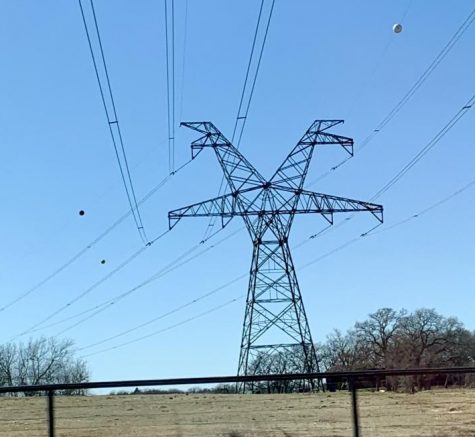Blizzards and Blackouts
Texas falls off grid thanks to record breaking weather
March 8, 2021

The winter storm hit Texas hard. For a state used to hot summers and mild winters, temperatures slipping into the negatives seemed surreal, but citizens quickly realized the severity of the situation. Water sources froze, pipes burst and the snow suddenly wasn’t a welcome sight. When the electricity clicked off for millions in Texas, temperatures indoors plunged to the 40s, leaving people scrambling to keep their families warm and safe. Kids slept in winter jackets, families piled into tents and layers became the norm as everyone desperately tried to keep the heat in. The statewide power outages, skyrocketing electric bills and damage caused from the storm proved one thing: everything is bigger in Texas.
Texas’ lack of all things winter lulled the state into a false sense of security. Power companies dislike splurging on the winterizing of their technology when Texas only experiences a few cold snaps each year. Despite the rarity of the event, February’s snow storm wasn’t the first of its kind. In Feb. 2011, Texas faced a similar predicament. The snow storm affected coal plants, wind turbines and froze natural gas wells, leading to power outages across the state. Experts urged power companies and regulators, such as ERCOT, to make the necessary investments to keep power plants from falling offline during extreme weather after the 2011 incident, but a decade later the proper fixes have yet to be made.
ERCOT, the company responsible for representing 90% of Texas’ electrical grid, made the call for rolling blackouts in face of the growing winter storm. While temperatures dropped, power plants tripped off due to the extreme cold. This placed extra strain on the remaining power sources while demand rose, brewing a disaster. To prevent a total shut down, grid operators started issuing rolling blackouts. The intention was for Texans to be without power for short periods of time, but the rolling blackouts left many in the dark for days. ERCOT might’ve left Texans out in the cold with rolling blackouts, but it was the lesser of the two evils. The alternative, an uncontrolled blackout, requires a startup that could have lasted weeks to months. Luckily, the thaw allowed ERCOT to bring their grids back online and restore power to most of Texas.
Glancing at a map of the outages, the few outages in the El Paso area and Panhandle strike a contrast to the outages that wrecked the rest of the state. ERCOT provides power for only 90% of the state- the other 10% receives their electricity from different sources. The difference between the power received from ERCOT and other grid providers are the regulations placed on each provider. Texas, unlike the other states, has its own power grid run by ERCOT. Texas’ power grid operates mostly isolated from other states and the limited regulations along with lack of federal oversight helps explain how the power outage became reality for Texans. Without actual rules stating what temperatures machinery needs to withstand, winterizing power plants is an option rather than a requirement.
After a week of snow, Texas finally thawed, returning the green grass and sunshine its citizens are so accustomed to. Power flickered back on in homes and businesses, but life isn’t back to normal. Pipes burst, causing water damage and roofs to cave in. Some outdoor heating units acquired permanent damage from the snow, meaning a new unit must be installed. Those affected by the snow storm stay with family members or hotels while waiting for the repairs to be made. Even with water damage and broken heaters, Texans hold their friends and family close, just happy they all weathered the storm.











Jose Lopez • Mar 26, 2021 at 8:08 am
Loved the story keep up the great work. Can’t wait for your next story.
Priyanshu Patel • Mar 11, 2021 at 2:01 pm
I like this article because it talked about the crazy storm we had and the blackouts that happened. The article included all the info that made it good and stated all the facts.
alexia.vega • Mar 11, 2021 at 8:50 am
I really like your article Blizzards and Blackouts. The whole winter storm was bad for many families everywhere. I really enjoyed reading your article very much and can’t wait to see what your going to write about next.
daisy villegas • Mar 11, 2021 at 8:21 am
This article gives off so mcuh good information thats not false by what Texas has experince this past month, it was very good. i cant wait to see more!!! helped me view of how i should better my writing.
Krystal Lopez • Mar 11, 2021 at 8:18 am
I like how you mentioned the struggle and the difficultness situation we were all in during the blizzard and blackout and how you explained our situation. I can’t wait to see more of how you put everyones perspective through that period of time.
Kirsten Evans • Mar 11, 2021 at 8:15 am
This was really well written, Texas defianatly wasn’t ready for the weather. It surprised all of us more than anything
Alicia guevara • Mar 11, 2021 at 8:12 am
A lot of families did have to go through a lot of stuff not having water and no power and have to go somewhere else to keep warm and know everything is back to normal everyone has running water and power.
Avi Lujan • Mar 11, 2021 at 8:10 am
I liked that they talked about what the effects were due to the snow storm in Texas and how people had to go through that. I can’t wait to see more about topics like this and how people are still dealing with these causes now.
Kayley MacKenzie • Mar 11, 2021 at 8:09 am
This is a really good article and it was put together well.
Alexis Bishop • Mar 11, 2021 at 8:06 am
I like that you included the information relating to the power company, and why the power failure occurred. I also appreciate the mention of how electric bills increased despite many not having power, as I haven’t seen much coverage of that.
George R. • Mar 11, 2021 at 8:04 am
Enjoyed another persons insight on all of this! Although that seems like a distant memory, the rest of the state is still facing the consequences and aftermath of the freeze. Lots of information on this, liked how all of the important info was given first!
Macey Owens • Mar 11, 2021 at 8:02 am
Awesome job! I love the little Texas joke and all the information on the snowstorm. You told readers about ERCOT and let them know what it was. Keep up the good work.